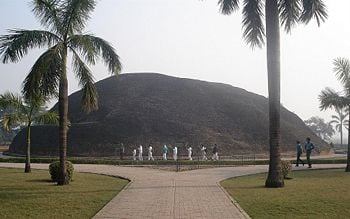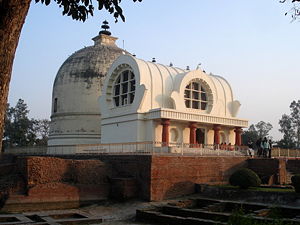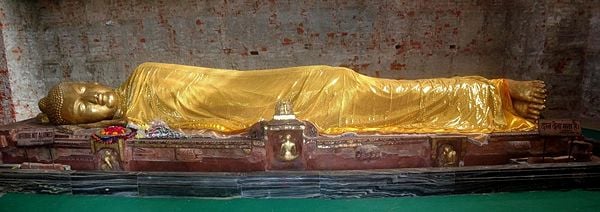Kushinagar
Kushinagar or Kusinagar is a town and a nagar panchayat in Kushinagar district in the Indian state of Uttar Pradesh. It is an important Buddhist pilgrimage site, where Gautama Buddha died.
Ancient history
In ancient times, it was known as Kushavati (Jatakas). Kushinagar was a celebrated center of the Malla kingdom of ancient India. Later, it would be known as Kushinara, one of the most important four holy sites for Buddhists. At this location, near the Hiranyavati River, Gautama Buddha attained Parinirvana (or 'Final Nirvana') after falling ill from eating a meal of a species of mushroom which translates as "pig's delight".
Many of the ruined stupas and viharas here date back to 3rd century B.C.E. - 5th century CE when prosperity was at its peak. The Mauryan emperor Ashoka is known to have contributed to significant construction at this site.
Prior to its rediscovery in the 19th century, there was a silence of more than half a millennium at Kasia. Due to violent invasions, Kushinagar lost its vitality and eventually was neglected.
Visits by Buddha to Kushinagar
| Pilgrimage to Buddha's Holy Sites |

|
| The Four Main Sites |
|---|
| Lumbini · Bodh Gaya Sarnath · Kushinagar |
| Four Additional Sites |
| Sravasti · Rajgir Sankissa · Vaishali |
| Other Sites |
| Patna · Gaya Kausambi · Mathura Kapilavastu · Devadaha Kesariya · Pava Nalanda · Varanasi |
At the time of the Buddha, Kushinagar was the capital of the Mallas, and the scene of the Buddha's death. It was twenty-five yojanas from Rajagaha (DA.ii.609; acc. to Fa Hsien, p.40, it was twenty-four yojanas from Kapilavatthu) and lay on the high road from Alaka to Rájagaha, the road taken by Bávarí's disciples (SN.v.1012). At that time it was a small city, "a branch-township with wattle-and-daub houses in the midst of the jungle," and Ananda was, at first, disappointed that the Buddha should have chosen it for his Parinibbana. But the Buddha, by preaching the Maha-Sudassana Sutta, pointed out to him that in ancient times it had been Kusavati, the royal city of Maha-Sudassana (D.ii.146).
It is said that the Buddha had three reasons for coming to Kusinárá to die:
- Because it was the proper venue for the preaching of the Mahá-Sudassana Sutta;
- Because Subhadda would visit him there and, after listening to his sermon, would develop meditation and become an arahant while the Buddha was still alive; and
- Because the brahman Doha would be there, after the Buddha's death, to solve the problem of the distribution of his relics (UdA.402f; DA.ii.573f6).
Between Kusinara and Pava, three gavutas away (DA.ii.573) - from where the Buddha came to Kusinára on his last journey from Rajagaha, stopping at various places - lay the stream of Kakuttha on the banks of which was the Ambavana; beyond that was the Hiraññavati river, and near the city, in a south-westerly direction, lay the Upavattana, the Sala-grove of the Mallas, which the Buddha made his last resting-place (UdA.238; DA.ii.572f).
After the Buddha's death his body was carried into the city by the northern gate and out of the city by the eastern gate; to the east of the city was Makutabandhana, the shrine of the Mallas, and there the body was cremated. For seven days those assembled at the ceremony held a festival in honour of the relics (D.ii.160f).
As the scene of his death, Kusinara became one of the four holy places declared by the Buddha to be fit places of pilgrimage for the pious, the other three being Kapilavatthu, Buddhagaya and Isipatana (D.ii.140).
Mention is made of other visits paid to Kusinárá by the Buddha, prior to that when his death took place. Thus, once he went there from Ápana and having spent some time at Kusinárá, proceeded to Átumá. The Mallas of Kusinárá were always great admirers of the Buddha, even though not all of them were his followers, and on the occasion of this visit they decided that any inhabitant of Kusinárá who failed to go and meet the Buddha and escort him to the city, would be fined five hundred. It was on this occasion that Roja the Mallan was converted and gave to the Buddha and the monks a supply of green vegetables and pastries (Vin.i.247f). During some of these visits the Buddha stayed in a wood called Baliharana, and there he preached two of the Kusinárá Suttas (A.i.274f; v.79f) and the "Kinti" Sutta (M.ii.238f). A third Kusinárá Sutta he preached while staying at Upavattana. (A.ii.79; for another discourse to some noisy monks at Upavattana, see Ud.iv.2).
According to a late tradition, one-eighth of the Buddha's relics were deposited in a cairn in Kusinárá and honoured by the Mallas (D.ii.167; Bu.xxviii.3).
In Hiouen Thsang's day there still existed towers and Sarighárámas erected to mark the spots connected with the Buddha's last days and obsequies at Kusinárá. According to his account (Beal. op. cit.li. lii. n) Kusinárá was nineteen yojanas from Vesáli. A copper plate belonging to the thúpa erected at the site of the Buddha's death has recently been discovered (CAGI.i.714).
Rediscovery
The remains of the Parinirvana Stupa and Parinirvana Temple, when rediscovered, were covered in a 40 foot high mound of bricks surrounded by a dense thorny forest. After E. Buchanan, an officer of the East India Company, arrived in Kasia in the course of his survey-work, H. H. Wilson, in 1854, made the suggestion that ancient Kushinagar and Kasia were the same. Work resumed around 1861-1862 when General Alexander Cunningham, an archaeological surveyor, would prove the site to be that of Gautama Buddha's passing. A British officer named Mr. A.C.L. Carlleyle followed suit. Excavations began in the late 1800s and many important remnants of the main site such as the Matha Kuar and Ramabhar stupa were unveiled.
Today
Today, Kushinagar is a much-frequented pilgrimage site for Indian and foreign tourists, and temples have been constructed by Indian, Chinese, Sri Lankan, Thai, Burmese, South Korean, Tibetan and Japanese Buddhists, alongside the ruins of monasteries and stupas. Kushinagar is one of the main four Buddhist pilgrimage sites related to the life of Gautama Buddha. The other three are Lumbini, Bodh Gaya, and Sarnath.
The two places most frequently visited in Kushinagar are the Mahaparinirvana Stupa, which is built on the place of Buddha's Mahaparinirvana (Great Nirvana or passing away), and the place of his cremation, which is 1.6 km away. Close to the Mahaparinirvana Stupa is located a 1500 year old Buddha-image of the Buddha as he attained Parinirvana. The Mahaparinirvana Stupa is surrounded by ruins of ancient monasteries.
Demographics
As of 2001 India census, Kushinagar had a population of 17,982. Males constitute 52% of the population and females 48%. Kushinagar has an average literacy rate of 62%, higher than the national average of 59.5%: male literacy is 70%, and female literacy is 54%. In Kushinagar, 15% of the population is under 6 years of age.
Notes
Resources
- Pryor, Robert. 1989. Buddhist pilgrimage to India and Nepal. Yellow Springs, Ohio: Insight Travel. (VHS tape)
External links
- Entry on Kusinara (Kushinagar) in the Dictionary of Pali Proper Names
- The Maitreya Project is building a 500ft/152m bronze statue of Maitreya Buddha near Kushinagar (previously planned in Bodhgaya).
- photos of Kushinagar ruins and stupas
Credits
New World Encyclopedia writers and editors rewrote and completed the Wikipedia article in accordance with New World Encyclopedia standards. This article abides by terms of the Creative Commons CC-by-sa 3.0 License (CC-by-sa), which may be used and disseminated with proper attribution. Credit is due under the terms of this license that can reference both the New World Encyclopedia contributors and the selfless volunteer contributors of the Wikimedia Foundation. To cite this article click here for a list of acceptable citing formats.The history of earlier contributions by wikipedians is accessible to researchers here:
The history of this article since it was imported to New World Encyclopedia:
Note: Some restrictions may apply to use of individual images which are separately licensed.



